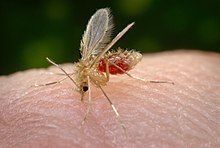| Phlebotomus papatasi | |
|---|---|

| |
| Phlebotomus papatasi feeding on human blood | |
| Scientific classification | |
| Domain: | Eukaryota |
| Kingdom: | Animalia |
| Phylum: | Arthropoda |
| Class: | Insecta |
| Order: | Diptera |
| Family: | Psychodidae |
| Genus: | Phlebotomus |
| Species: | P. papatasi
|
| Binomial name | |
| Phlebotomus papatasi (Scopoli, 1786)
| |
Phlebotomus papatasi is a species of insects commonly known as sandflies. Due to their ectothermic climate limitations, P. papatasi are confined to regions with temperatures above 15 degrees Celsius for at least three months of the year,[1] spanning over much of the European Mediterranean, North Africa, the Middle East, and Central Asia.[2] Around one thousand sandfly species have been described, belonging to the subfamily Phlebotominae within the family Psychodidae.[1] The Psychodidae family belongs to the order Diptera within the class Insecta of the subphylum Hexapoda of the Arthropod phylum.
Phlebotomus papatasi are translucent light brown in color, with two large, black compound eyes, six long legs, antennae, pedicel, a transparent abdomen, and a flagellum, totaling the sandfly's size to less than four millimeters in length. Small hairs cover the entire body and wings, which are constantly held at a forty-degree angle.[2] Due to P. papatasi belonging to the Diptera order, they are considered true flies in which the primary flight wings are membraned and the second set of smaller wings are used for balance.[3] The second set of wings are commonly referred to as halteres and they oscillate during flight to maintain the organism's orientation in space.[4] While they can fly, P. papatasi typically stay within a few hundred feet of breeding sites and travel with a mix of flight and hopping motions.[2]
Female adult P. papatasi are blood feeders on many vertebrate hosts and act as vectors for multiple infectious diseases, such as Old World Cutaneous Leishmaniasis and Pappataci fever, both of which will be further explored later in this article.
- ^ a b Cecilio, Pedro; Cordeiro-da-Silva, Anabela; Oliveira, Fabiano (April 4, 2022). "Sand flies: Basic information on the vectors of leishmaniasis and their interactions with leishmania parasites". Communiations Biology 5, 305(2022) on Nature.
- ^ a b c European Centre for Disease Prevention and Control (June 15, 2020). "Phlebotomine sand flies - Factsheet for experts". European Centre for Disease Prevention and Control.
- ^ "Insects and their allies: Diptera - flies and mosquitoes". Commonwealth Scientific and Industrial Research Organization. Retrieved April 18, 2022.
- ^ Deora, Tanvi; Siddharth, S; Sane, Sanjay P. (November 16, 2021). "Wings and halteres act as coupled dual oscillators in flies". Evolutionary Biology on elifesciences.